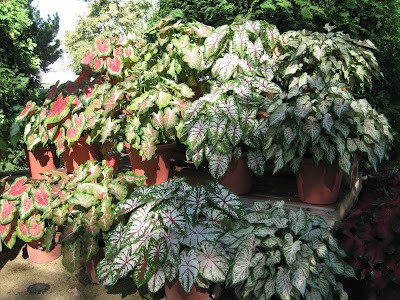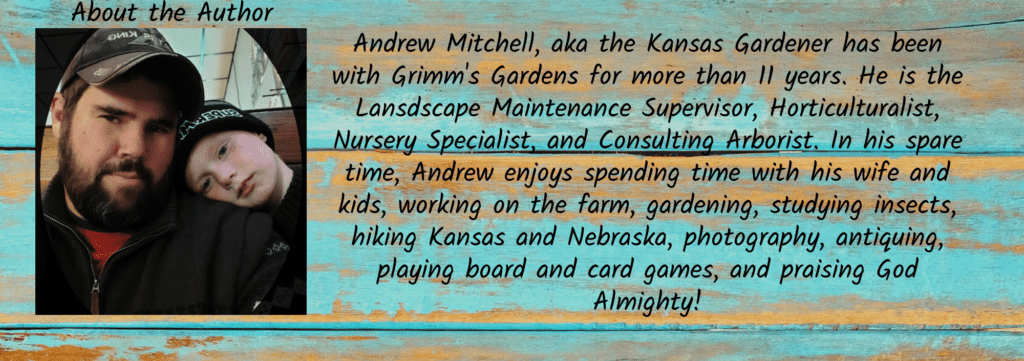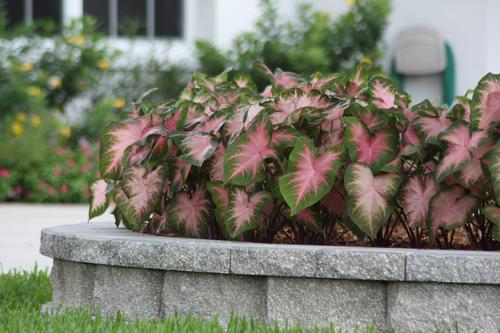The heat is almost over but there is so much of the year left. And caladiums are the top pick for the heat of summer. Ideally, many of you have already put caladiums into your containers, flower beds, or patio pots, but some of you may not know anything about them. What are caladiums? And how and where do they grow? What kind of watering do they need, or not need? And where can I get them?
I have been designing container plantings for customers for about 15 years now, go back to before I worked for Grimm’s Gardens. And one of the most easy to use, shade and sun tolerant plant is the caladium. A member of the Arum Family, they are cousins to Jack-in-the-Pulpit, Calla lilies, and the lowly skunk cabbage. However, caladiums are more tropical looking than many of its family members.
The large arrowhead-shaped leaves of caladium come in a variety of colors and love the heat and humidity of the Central Great Plains, though not our winters. Using them in containers and garden beds is easy once you get to know them.
Where to Plant Caladiums and How to Make Them Thrive
It is not always easy to tell a gardener not to water your plants. But with caladiums, I can say just that. Do not water them. At least, do not water them after the initial planting. I try to put in all of my annual color beds and containers during the 3rd week of May, which is typically rainy in Northeast Kansas. This boost of nitrogen containing water helps plants with their new soil surroundings.
Thanks to breeding programs, caladiums thrive in both sun and shade conditions, depending on their leaf color. Lighter colored leaves that are pale green, white, or light pink may burn more in full sun, while red, dark pink, and dark green leaves can handle it. I love using caladiums in deep to light shade containers, especially since there are so few suitable shade annuals for containers.
Another way to help your caladiums thrive is to give them a boost of fertilizer at planting. I like to use Fertilome’s Rose and Flower Food, which has an analysis of 14-12-11. This means that there is 14 lbs of Nitrogen, 12 lbs of Phosphorus, and 11 lbs of Potassium for every 100 lbs of fertilizer. This early boost of fertilizer will help plants thrive when the heat rolls in.
Using Caladiums in Shade Containers
But what do you mix with caladiums in those containers? Or do you just use them? Certainly, you could put together an entire container of caladiums, with no supporting annuals or perennials. But the best containers contain at least 2 different plants. The following is a list of annuals and perennials I like to use in my shade containers.

- Caladiums
- Birds Nest Fern
- Ostrich Fern
- Japanese painted fern
- Hostas
- Coral Bells
- Variegated plectranthus
- Shrimp plant
- Spider plant
- Coleus
- Angelwing begonias
- Rex begonias
- Impatiens
- Snake plant
- Dead nettle
Using Caladiums in Sun
Whether you use them in containers or in mass planting in annual beds, caladiums fill a need and the spot they are in. Being mostly pest and disease free (even Japanese beetles do not eat them), is one of the best reasons for using them in the landscape. One of the best ways to use them is in large massings in front of larger annuals such as large coleus, salvia, or cannas, or behind smaller annuals such as petunias, ornamental sweet potato vine, or impatiens.
No matter how you use them, caladiums make an impression on anyone who sees them in full sun. So use them. Add them to your containers and gardens. And enjoy their tropical look. Get them in person or online at Grimm’s Gardens.

Conclusion
Caladiums are fun, tropical-looking, heat-loving, and drought tolerant annuals for the Central Great Plains and many other regions. Plant them as soon as the soil temperatures reach 60 degrees F and enjoy the exciting look they add to the garden.
Happy planting!





Thanks for your info. I use the light colored ones in hay racks in the shade. They love it there and add color to an older privacy fence.